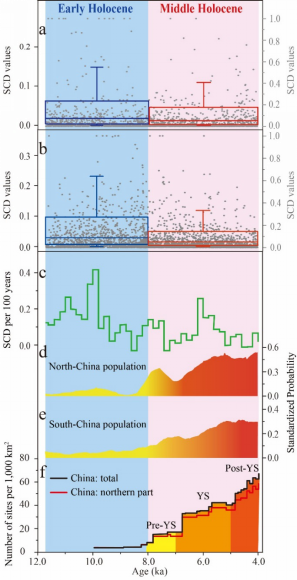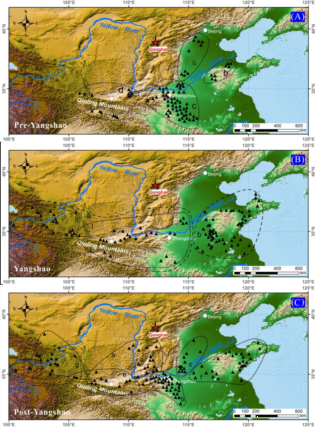Climate change is one of the most important global issues at present. To understand the relationship between climate change and the development of prehistoric culture in the geological history period (a period when human beings themselves are weak in adaptation to climate and environment changes) is of great significance for promoting the harmonious coexistence between human and nature, and also the construction of ecological civilization in the background of future warming.
The Holocene (since 11,700) is the most recent interglacial period. Because of the close climate boundary conditions to nowadays, the process and mechanism of climate and environment changes in this period have always been a hot topic in academic circles. As the geological history "similarity" of climate and environment conditions under the background of global warming in the future, the Holocene climatic optimum period (natural warming period) is the focus of academic research in the Holocene period. However, there is still much debate about whether the Holocene climatic optimum occurred simultaneously in different regions of East Asia, and whether it occurred in the Early Holocene (about 11,700-8000 years ago) or the Middle Holocene (about 8000-4000 years ago). For example, An et al. [1] believed that the Holocene climatic optimum period in East Asia has diachronism, that is, the Holocene climatic optimum period appeared in the Early Holocene in Northeast China, while it appeared in the Middle Holocene in the Yangtze River region of China. Although Zhou et al. [2] and Jiang et al. [3] also agreed that the Holocene climatic suitability period in East Asia was of diachronism, they propose that the Holocene climatic optimum period in northern China began in the Middle Holocene, while in southern China it began in the Early Holocene. In addition, many scholars have pointed out that the Holocene climatic optimum period appeared simultaneously in East Asia, while whether it occurred in the Early Holocene or the Middle Holocene, there is still a big disagreement among various parties.
In the above studies on the debate on the beginning and end of the Holocene climatic optimum period, the definition of the Holocene climatic optimum period is mainly based on temperature and(or) precipitation intensity. However, it should not be defined only by the intensity of climatic factors that the optimal conditions of climatic environment closely related to the survival and development of prehistoric human beings, and the climate stability may have a greater impact on the development of prehistoric society than the mean state (intensity) of climate [4]. This is because in the geological history period, the material production means were limited and the production technology was backward, also prehistoric people had certain limitations in resisting the rapid climate change, and thus had weaker ability to adapt to the rapid climate change. Previous studies, for example, have linked the collapse of much of the Neolithic culture in China, the disappearance of the Angkor culture in Cambodia, and the decline of the Mayan civilization in the Americas to the unstable climate of the time. Therefore, the assessment of the climatic states of the Early and Middle Holocene in East Asia from the perspective of climate stability may provide a new research idea for resolving the debate on the spatiotemporal variation of the climatic optimum period in East Asia during the Holocene.
The densely populated eastern part of China is the core area affected by the East Asian summer monsoon. Compared with the temperature change, the flood disasters caused by the abnormal changes of East Asian summer monsoon precipitation have a greater impact on the regional social and economic development. Therefore, in order to raise awareness and understand the regional spatial and temporal variation characteristics of the Holocene climatic optimum period, and evaluate its impact on the development of prehistoric culture, a team from Lanzhou University and the Institute of Tibetan Plateau Research, Chinese Academy of Sciences, explored this scientific issue by comparing and analyzing high-resolution paleoclimatic records of lakes, peat, loess, and stalagmites in East Asia. The relevant research results have recently been published online in the world-famous geoscience journal Earth-Sciences Reviews (Vol.212, January 2021). Zhiping Zhang, a PhD candidate from the College of Earth and Environmental Sciences, Lanzhou University, is the first author of the research paper. The corresponding author is Jianbao Liu, a researcher from the Institute of Tibetan Plateau Research, Chinese Academy of Sciences. Based on strict paleoclimate record selection criteria, 12 records that clearly reflect East Asian monsoon precipitation (humidity) and 11 stalagmite oxygen isotope records that reflect changes in monsoon circulation were selected. Besides, the differences between each record sample were quantified by using squared chord distance (SCD). It showed that a higher SCD value indicates a greater variation between samples, reflecting a more unstable climate. The results showed that both individual paleoclimate records and the integration of all records showed a more stable climate in the Middle Holocene of East Asia compared with the Early Holocene (Figure 1).

Figure 1 Climate stability of the Early-Middle Holocene in East Asia (a and b are the climate stability sequences based on precipitation (humidity) records and stalagmite oxygen isotope records, respectively) compared with vegetation (c), population (d and e), and number of prehistoric cultural sites (f)
The research team further compared the relationship between climate stability and changes in vegetation, prehistoric population, and prehistoric cultural sites in East Asia during the Early-Middle Holocene (Figure 1). The results showed that vegetation was also more stable in the Middle Holocene, when the climate was more stable, and the number of prehistoric population and prehistoric cultural sites represented by the Yangshao culture showed a significant upward trend in the Middle Holocene (Figure 1). Based on the coupled relationship between climate stability, vegetation, prehistoric population, and the number of sites in the Early-Middle Holocene of East Asia, the Middle Holocene with its stable climate provided favorable conditions for the development of agriculture and animal husbandry, which contributed to the rapid growth of prehistoric population and the prosperity of the Yangshao culture, the most representative Neolithic culture in northern China in the Holocene (Figure 2). Accordingly, this study suggested that the Middle Holocene, with its stable and strong East Asian summer monsoon climate, is more suitable as the Holocene climatic optimum period.

Figure 2 Spatial and temporal patterns of Neolithic cultural evolution in the Yellow River basin. a. Pre-Yangshao culture; b. Yangshao culture period; c. Late Yangshao culture (cited in Chen et al. [5])
Finally, the research team used the TraCE-21 ka climate model to reveal the mechanism of the difference in climate stability between the Early and Middle Holocene in East Asia. It was found that compared to the early Holocene, the Middle Holocene ice cap completely melted and the ice cap disappeared from blocking the westerly winds, which made the mid-latitude westerly wind belt oscillation weaker and further reduced the East Asian monsoon variability through the westerly-monsoon interaction, resulting in a more stable East Asian monsoon climate in the Middle Holocene.
This study provides a new solution to the debate on the start and end of the Holocene climatic optimum period from the perspective of climate stability, and changes the perception that the Holocene climatic optimum period is defined only by the climate mean (intensity) in previous studies. This study will further promote the discussion on the relationship between climate change and prehistoric cultural change, and help promote the interdisciplinary intersection and development of paleoclimatology and archaeology.
This work was supported by the National Natural Science Foundation of China (Grants 41790421, 41722105).The original link of the paper:https://www.sciencedirect.com/science/article/pii/S0012825220304967